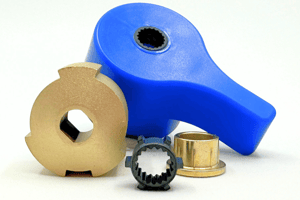Powder Metal Conversion Results in Significant Cost Reduction with Design Optimization. Let Us Help...
Application of Powder Metallurgy to Convert Parts: Uses & Benefits

Powder metallurgy (PM) conversions have emerged as a game-changer for many companies limited by competing forming processes. If your project is compatible with powder metal applications, conversions can result in significant cost reductions, increased part consistency, and decreased production time.
If you’re currently using a non-powder metal process that’s lacking in efficiency, you may want to evaluate your design for conversion potential. There are a few key steps to doing that:
What Is a Powder Metal Conversion?
A PM conversion is a change in process and material to powder metallurgy from a competing forming process like:
- Stamping
- Plastics
- Casting
- Machining
- Cold forming
Not every design is a candidate for a conversion. However, new powder metallurgy manufacturing technologies and materials have expanded the types of components that the powder metal process can produce.
Advantages of Powder Metal Application Over Other Processes
Design of even the smallest component is a highly considered business decision for companies. So, why put in the effort to change course from the status quo?
The powder metallurgy process, compared with other metal forming applications, provides a host of advantages:
- Powder metallurgy products offer better part-to-part uniformity –– from the first part to the last, your part’s quality will be consistent.
- Custom tooling and an additive material process give you shape flexibility to optimize designs with complex geometries.
- There’s a wide variety of metal powder materials, including those heat-treatable for high strength and wear resistance.
- With a vast range of application versatility, powder metallurgy parts are viable in almost every industry.
- Lower energy consumption, higher material utilization, increased production speeds, and limited secondary operation requirements make powder metal cost-effective and a recognized green technology.
- Powder metallurgy offers the opportunity to transform an assembly into a single part pressed to net shape – saving you time, SKUs, and money.
.gif?width=400&height=224&name=Conversions%20Blog%201%20(2).gif)
How Do I Know if My Part Has PM Potential?
To determine if your design might perform better or cost less as a powder metal part, work with a powder metallurgy supplier to conduct a comprehensive system review. The assessment will evaluate your current part’s materials, geometry, specifications, and application requirements to determine the suitability for an application of powder metallurgy.
As part of the assessment, your powder metallurgy part supplier may ask:
- What material is being used for the current forming process?
- What material characteristics are important for the application?
- What environmental conditions will the part be exposed to?
- Are there specific mechanical property or wear resistance requirements?
- How do you currently assemble the part?
- What are the end-use needs and requirements?
- Does the part have specific finish requirements?
Powder Metal Conversion Success Stories
This isn’t theory – auto, appliance, and agriculture manufacturers are redesigning their parts for powder metallurgy every day. Here are a few real-world examples of how companies like yours are leveraging the process.
Success Story 1: Powder Metal Hinge Conversion
A key supplier to the household appliance market was looking for a solution to improve its appliance hinge. The original stamping was a subassembly that required stacking, aligning, and securing the three stamped parts.
In converting to PM, this three-piece subassembly became a single-stroke, net-shape component with added design features. The benefits of this conversion included:
- Improved part cost by eliminating assembly and machining operations
- Enhanced, smooth-running surface for the roller assembly
- Integration of additional features, resulting in improved installation time for the finished assembly
Success Story 2: Hand-Tool Assembly Conversion
A hand tool manufacturer was looking for a solution to improve its component’s design, performance, cost, and assembly time. The original subassembly required three individual parts: a stamped sprocket, a machined lower body, and a fastener.
Using the powder metal process, the three-part subassembly shrunk to one multilevel, net-shape component, which resulted in:
- Lower number of SKUs the customer had to purchase
- Reduced assembly time
- Improved general appearance and performance
- Reduced final cost by $1 per assembly
More Powder Metal Conversion Resources
The powder metal process can compete with a surprising number of stamping, casting, machining, and cold forming applications. Customers tend to find that, when suitable, converting their designs to PM results in:
- More consistent batches
- Faster production
- Higher performance
- Reduced costs
There are additional resources for gauging whether powder metallurgy can improve your part’s design, consistency, performance, or cost. For starters, check out our whitepaper on sintered metal as a replacement for machining:
(This blog post was recently updated with new insights.)






